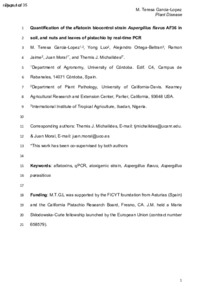| dc.contributor.author | Garcia-Lopez, M.T. |
| dc.contributor.author | Luo, Y. |
| dc.contributor.author | Ortega-Beltran, A. |
| dc.contributor.author | Jaime, R. |
| dc.contributor.author | Moral, J. |
| dc.contributor.author | Michailides, T. |
| dc.date.accessioned | 2021-01-19T11:24:11Z |
| dc.date.available | 2021-01-19T11:24:11Z |
| dc.date.issued | 2020-10 |
| dc.identifier.citation | Garcia-Lopez, M.T., Luo, Y., Ortega-Beltran, A., Jaime, R., Moral, J. & Michailides, T. (2020). Quantification of the aflatoxin biocontrol strain Aspergillus flavus AF36 in soil, and nuts and leaves of pistachio by real-time PCR. Plant Disease, 1-43. |
| dc.identifier.issn | 0191-2917 |
| dc.identifier.uri | https://hdl.handle.net/20.500.12478/7008 |
| dc.description.abstract | The species Aspergillus flavus and A. parasiticus are commonly found in the soils of nut-growing areas in California. Several isolates can produce aflatoxins that occasionally contaminate nut kernels conditioning their sale. The strain AF36 of A. flavus, which does not produce aflatoxins, is registered as a biocontrol agent for use in almond, pistachio, and fig crops in California. After application in the orchards, AF36 displaces aflatoxin-producing Aspergillus spp. and thus reduces aflatoxin contamination. Vegetative compatibility assays (VCA) have traditionally been used to track AF36 in soils and crops where it has been applied. However, VCA is labor-intensive and time-consuming. Here, we developed a quantitative real-time PCR (qPCR) protocol to quantify proportions of AF36 accurately and efficiently in different substrates. Specific primers to target AF36 and toxigenic strains of A. flavus and A. parasiticus were designed based on sequence of aflC, a gene essential for aflatoxin biosynthesis. Standard curves were generated to calculate proportions of AF36 based on threshold values (Cq). Verification assays using pure DNA and conidial suspension mixtures demonstrated a significant relationship by regression analysis between known and qPCR-measured AF36 proportions in DNA (R2 = 0.974; P < 0.001) and conidia mixtures (R2 = 0.950; P < 0.001). The tests conducted by qPCR in pistachio leaves, nuts, and soil samples demonstrated the usefulness of the qPCR method to precisely quantify proportions of AF36 in diverse substrates, ensuring important time and cost savings. The outputs of the current study will serve to design better aflatoxin management strategies for pistachio and other crops. |
| dc.description.sponsorship | FICYT foundation, Asturias |
| dc.description.sponsorship | California Pistachio Research Board |
| dc.description.sponsorship | European Union |
| dc.format.extent | 1-43 |
| dc.language.iso | en |
| dc.subject | Aflatoxins |
| dc.subject | Aspergillus Flavus |
| dc.subject | Aspergillus Parasiticus |
| dc.subject | Biological Control |
| dc.title | Quantification of the aflatoxin biocontrol strain Aspergillus flavus AF36 in soil, and nuts and leaves of pistachio by real-time PCR |
| dc.type | Journal Article |
| cg.contributor.crp | Agriculture for Nutrition and Health |
| cg.contributor.affiliation | Universidad de Córdoba |
| cg.contributor.affiliation | University of California |
| cg.contributor.affiliation | International Institute of Tropical Agriculture |
| cg.coverage.country | United States of America |
| cg.coverage.hub | Headquarters and Western Africa Hub |
| cg.researchtheme | Plant Production and Health |
| cg.identifier.bibtexciteid | GARCIALOPEZ:2020 |
| cg.isijournal | ISI Journal |
| cg.authorship.types | CGIAR and advanced research institute |
| cg.iitasubject | Aflatoxin |
| cg.iitasubject | Agronomy |
| cg.iitasubject | Disease Control |
| cg.iitasubject | Plant Diseases |
| cg.iitasubject | Plant Health |
| cg.iitasubject | Plant Production |
| cg.journal | Plant Disease |
| cg.notes | Published online: 21 Oct 2020 |
| cg.accessibilitystatus | Limited Access |
| cg.reviewstatus | Peer Review |
| cg.usagerightslicense | Copyrighted; all rights reserved |
| cg.targetaudience | Scientists |
| cg.identifier.doi | https://dx.doi.org/10.1094/pdis-05-20-1097-re |
| cg.iitaauthor.identifier | Alejandro Ortega-Beltran: 0000-0003-3747-8094 |
| cg.futureupdate.description | Not yet published. Online version only. |
| cg.futureupdate.required | Yes |
| cg.futureupdate.duration | 3 Months |

